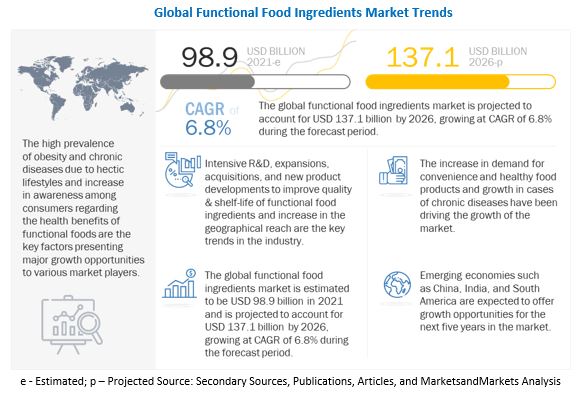
The global functional food ingredients market is expected to reach USD 137.1 billion by 2026, growing at a CAGR of 6.8% during the forecast period. The market is driven by the rising health awareness among the global population, which has led to the development of a wide range of applications of functional food ingredients such as fortifying food and beverage products.
Download PDF brochure: https://www.marketsandmarkets.com/pdfdownloadNew.asp?id=9242020
Probiotics segment dominates the market due to numerous health benefits
Probiotics are the most dominant segment of the functional food ingredients market, providing numerous health benefits beyond basic nutritional value. Their use has been shown to assist the body’s naturally occurring gut microbiota, preventing diarrhea caused by antibiotics, or as part of the treatment of antibiotic-related dysbiosis. Probiotics also have potential functional properties such as antigenotoxicity, antimutagenicity, and anticarcinogenicity, which can decrease the risk of cancer. The consumption of fermented dairy products is associated with a lower prevalence of colon cancer, suggesting that probiotics can inhibit carcinogens and procarcinogens.
Plant-sourced natural functional food ingredients grow rapidly due to their nutritional profile, low carbon footprint, and low price
Most functional food ingredients are sourced naturally. Consumer awareness about the health benefits of natural sources is driving the natural segment. Although synthetic ingredients are cheaper, growing awareness about the health benefits of natural ingredients is driving growth in the natural segment over the synthetic segment. North America and Europe are the mainstay markets for natural functional food ingredients. Plant protein is gaining importance due to its lower environmental impact, energy consumption, emissions, land use, water consumption, and better input conversion efficiency.
Cost-effective food products with high nutritional benefits drive the market
The market for functional food is increasing as consumers prefer balanced diets and food that enhances their immunological tolerance. This, along with product innovations in terms of flavors and variant offerings, presents significant opportunities for growth in the functional food ingredients market. Consumer interest in functional foods is fueled by rapid advances in science and technology, increasing health care costs, aging, and interest in attaining wellness through diet, among others. The snacks sub-segment is projected to grow at the highest CAGR during the forecast period, as customers around the globe are increasingly inclined toward food items that can be consumed easily. The Asia Pacific region has seen an increase in demand for snacks and convenience food products, leading to a rise in demand for various functional food ingredients that have led consumers to adopt healthier lifestyles.
Request Sample Pages: https://www.marketsandmarkets.com/requestsampleNew.asp?id=9242020
North America’s health-consciousness drives the market
The North American functional food ingredients market is driven by consumers’ increasing health-consciousness, which has led to the growth of the market. Consumers are seeking balanced diets and food that enhances their immunological tolerance, which is driving growth in the functional food ingredients market.
In conclusion, the global functional food ingredients market is expected to grow significantly due to the increasing health awareness among the global population. The natural segment is expected to grow faster than the synthetic segment due to growing consumer demand for natural ingredients. Probiotics are the dominant segment, offering numerous health benefits. Plant protein is also gaining importance due to its lower environmental impact. The cost-effective production of food products with high nutritional benefits is driving the market, along with product innovations and the rise in demand for snacks and convenience food products. The North American market is driven by the increasing health-consciousness of consumers.
